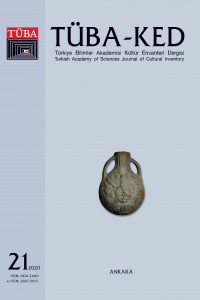MODERN MİMARLIK MİRASI OLARAK KERVANSARAY MOKAMPLARI VE KIZKALESİ MOKAMP KORUMA YAKLAŞIMI
Abstract
Kervansaray AŞ İngiliz petrol şirketi British Petroleum’un (BP) Türkiye turizmine katkı amacı ile kurduğu bir anonim şirkettir. 1960’ların başında kurulan bu şirket bünyesinde Türkiye’nin farklı yerlerinde 10 mokamp tesisi inşa edilmiştir. Türkiye’deki yabancı sermayeli ilk turizm yatırımlarından biri olan Kervansaray Mokampları yeni bir turizm şekli için tasarlanmış öncü mimari tasarımlardır. Kervansaray Mokamplarının tasarımcısı karikatürist, ressam ve mimar Güngör Kabakçıoğlu’dur.
Bu yazının amacı, modern mimari tasarım yaklaşımlarını yansıtan ve döneminin sosyal ve ekonomik yapısının belgesi olan Kervansaray Mokamplarının sahip olduğu kültürel değerleri ortaya koymak ve günümüze büyük oranda özgün olarak ulaşabilmiş olan Kızkalesi Mokamp’ı koruma yaklaşımlarını tanımlamaktır. Mokampların kampçı kullanımı için tasarlanan ana servis yapılarını inceleyen bu yazı kapsamında, birinci bölümde Kervansaray AŞ ve Güngör Kabakçıoğlu hakkında genel bilgiler verilirken, ikinci bölümde 10 adet mokamp alanındaki ana servis yapılarının mimari biçimlenmeleri anlatılmaktadır. Üçüncü bölümde, Kızkalesi Mokamp’ı ana servis yapısı ve zaman içinde geçirdiği değişimler sunulmaktadır. Son bölümde, mokamp yapıları üzerine genel değerlendirmeler ve Kızkalesi Mokamp’ının korunması için öneriler yer almaktadır.
References
- ÇEKEN H., 2003, “Türk Turizminde Yabancı Sermaye ve Yabancı Sermaye Ortamının İyileştirilmesine Yönelik Öneriler”, Balıkesir Üniversitesi Sosyal Bilimler Dergisi, Vol. 6, S. 10, s. 25-45.
- E.O., 26 Temmuz 1965, “Mokamplar Turist Sayısını Artırıyor”, Cumhuriyet, 5.
- KABAKÇIOĞLU, G., 1964, “Kervansaray Mocampları (BP Petrolleri ve Kervansaray Mimarı)”, Mimarlık, S.7, s. 15-16.
- KABAKÇIOĞLU, G., 1966, “Turistik tesislerden Örnekler: Kervansaray Mokampları”, Mimarlık, S.8, s. 18-21.
- KABAKÇIOĞLU, G., 1976, “Tarihi Milli Park Göremede Bir Mocamp”, Yapı, S.17, s. 54-57.
- KABAKÇIOĞLU G., 2018 Güngör Kabakçıoğlu, İstanbul, Mimarlık Vakfı.
- NAYCI, N., 2019. “Türkiye Turizm Tarihinde Bir Kavşak Noktası: Aksaray Ağaçlı Turistik Tesisleri”, Mimarlık, S. 406, s. 61-66.
- SEZGİN, O. M., 1 Ağustos 1973, “Türk Turizminde büyük isim: Mersin”, Cumhuriyet, 5.
- Cumhuriyet Gazetesi, 9 Ağustos 1965, “Turizme Hizmet Türk Ekonomisine Hizmettir”, Cumhuriyet, 3.
- Cumhuriyet Gazetesi, 1 Ağustos 1965, “Turizme Hizmet Türk Ekonomisine Hizmettir”, Cumhuriyet, 3.
- Cumhuriyet Gazetesi, 9 Mayıs 1967, “Sorular-Cevaplar”, Cumhuriyet, 6.
- Cumhuriyet Dergisi, 2 Nisan 1979, Cumhuriyet Dergi, 21.
Details
| Primary Language | Turkish |
|---|---|
| Subjects | Cultural Studies |
| Journal Section | Research Articles |
| Authors | |
| Publication Date | September 17, 2020 |
| Submission Date | April 23, 2020 |
| Published in Issue | Year 2020 Issue: 21 |
Publisher
Vedat Dalokay Caddesi No: 112 Çankaya 06670 ANKARA
TÜBA-KED Turkish Academy of Sciences Journal of Cultural Inventory (TÜBA-KED) does not officially endorse the views expressed in the articles published in the journal, nor does it guarantee any product or service advertisements that may appear in the print or online versions. The scientific and legal responsibility for the published articles belongs solely to the authors.
Images, figures, tables, and other materials submitted with manuscripts must be original. If previously published, written permission from the copyright holder must be provided for reproduction in both print and online versions. Authors retain the copyright of their works; however, upon publication in the journal, the economic rights and rights of public communication -including adaptation, reproduction, representation, printing, publishing, and distribution rights- are transferred to the Turkish Academy of Sciences (TÜBA), the publisher of the journal. Copyright of all published content (text and visual materials) belongs to the journal in terms of usage and distribution. No payment is made to the authors under the name of copyright or any other title, and no article processing charges are requested. However, the cost of reprints, if requested, is the responsibility of the authors.
In order to promote global open access to scientific knowledge and research, TÜBA allows all content published online (unless otherwise stated) to be freely used by readers, researchers, and institutions. Such use (including linking, downloading, distribution, printing, copying, or reproduction in any medium) is permitted under the Creative Commons Attribution-NonCommercial-NoDerivatives 4.0 International (CC BY-NC-ND 4.0) License, provided that the original work is properly cited, not modified, and not used for commercial purposes. For permission regarding commercial use, please contact the publisher.

